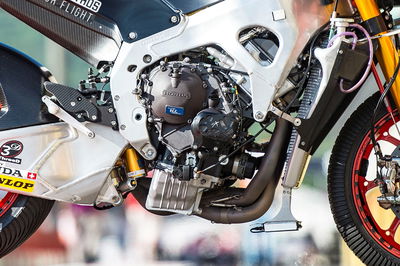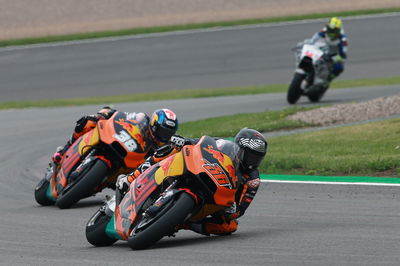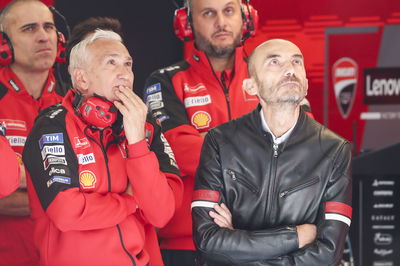EXCLUSIVE: Danny Aldridge (Technical Director) - Interview
The 2017 Moto2 season saw two riders disqualified for the unusual offence of using oil 'outside the FIM Moto2 specifications'.
The initial occurrence meant Mattia Pasini (Italtrans) was stripped of second place in Catalunya. But the same infringement then cost Dominique Aegerter (Kiefer) what would have been Suter's only victory - and podium - of the season, in Misano.

The 2017 Moto2 season saw two riders disqualified for the unusual offence of using oil 'outside the FIM Moto2 specifications'.
The initial occurrence meant Mattia Pasini (Italtrans) was stripped of second place in Catalunya. But the same infringement then cost Dominique Aegerter (Kiefer) what would have been Suter's only victory - and podium - of the season, in Misano.
The technical rules state: "Only engine oil from the appointed oil supplier is permitted. This oil will be available at all official events and will conform to the FIM Grand Prix specification for the relevant class. The use of the official oil without any addition or alteration is mandatory. The Technical Director may require that an oil sample be taken from any team or machine at any time.
"Oil will comply with the FIM Grand Prix Moto2 specification if it matches the reference Gas Chromatography fingerprint(s)… established by the appointed oil supplier."
Crash.net spoke to MotoGP Technical Director Danny Aldridge to find out more about the rule broken by the machines of Pasini and Aegerter…
Crash.net:
How do you check the legality of oil?
Danny Aldridge:
It's the same as with fuel, you basically have the official 'fingerprint' for the oil, which details what properties the oil should contain and you overlay the test results from a sample and see if there is any difference.
Crash.net:
Is it the responsibility of the teams to source and purchase the official oil?
Danny Aldridge:
No, we provide it. The official Moto2 and Moto3 oil is supplied by Liqui Moly and is supplied to the teams by us. It goes direct from Liqui Moly and the teams receive enough oil for all the European events at the start of the season. Then for the flyaways we bring all the oil with us, to save them money, and allocated it here at the track.
Crash.net:
How is the official oil 'fingerprint' determined and when do you test the bikes?
Danny Aldridge:
As with fuel, we send the original batch of oil, which is the same for everybody, off to a laboratory. The laboratory then tests it and that is the official fingerprint to work against.
Then during the season - at technical control, after qualifying and the race - we'll do oil tests. We bring in as many bikes as we want. The normal procedure is always the top three and a random bike. But we can if we want just bring in three or four random bikes. It's up to us. There's nothing in the rule book that specifies who we have to test.
But normally it's the top three and a random bike. As with fuel we always take two samples from all of those bikes, which is the 'A' and 'B' sample you've heard about. Sample A is then sent off to the laboratory, Sample B is kept by the FIM in case there is an issue.
Crash.net:
Who does the testing?
Danny Aldridge:
We use a specialist laboratory that does the testing on our behalf. They give a report back and if there is a discrepancy or issue when the oil is tested, I get the results first and make a report for the FIM Stewards.
If there is a problem the FIM Stewards then hold a meeting with the team and the team has the option to either accept the findings or request to have the B sample tested. Which obviously they would. The B sample is then sent off and we wait for the results of that.
I've seen in the media some people questioning why it took so long for the punishments to be given out.
The problem is you have the event, where you normally take the oil samples on the Saturday or Sunday. Then we need use a courier, normally DHL, to take the sealed bottles to the laboratory. Then the laboratory has to do all of the testing and report the results back to us.
It takes 3-4 days to get the samples to the laboratory, 3-4 days to complete all of the testing and if anything incorrect is found we cannot have a hearing with the team until the next grand prix.
Then the normal procedure is for the team to request that the B sample is tested and the whole courier and testing process is repeated, with a final hearing at the following event.
Crash.net:
How is the system different for MotoGP, where there are multiple fuel and oil suppliers?
Danny Aldridge:
In the MotoGP class, as the teams are allowed to choose their own oil supplier we don’t control the oil only the fuel specification, herefore we don’t carry out tests on MotoGP oil. With the fuel the teams are permitted to use different fuel brands as long as it meets the FIM regulations. So the teams/manufacturers are required to send off samples to the official laboratory at the start of the year. If at any point they change their batch of fuel, they would need send another sample.
Crash.net:
And they can change their fuel as long as they don't exceed certain parameters?
Danny Aldridge:
Yes, for example because fuel is made in much smaller batches, a sample is sent to the laboratory by each team or Manufacturer and normally it is the manufacturer, whenever the batch changes and the laboratory confirm that it meets the FIM standards and issue a conformity certificate which the teams need to present to technical control at each event, to confirm which batch of fuel they intent to use. We will then test against that confirmed fingerprint, until it is replaced by a newer version. In Moto2/3 it’s much easier as we supply the teams with the official fuel at each event, which is currently Elf. With Elf supplying me directly with the conformity certificate for that batch of fuel.
Crash.net:
Returning to the Moto2 oil test, what kind of tolerance is there? Where do you draw the line between passing and failing?
Danny Aldridge:
There are normally two scenarios. The first is that the sample could be completely different, so a different oil manufacturer.
The second is that the official oil has been tampered with. For example, if it has an additive that is not part of the official oil. So if an oil has three ingredients and we find a fourth, what's that doing there?
Either way, it's usually pretty clear.
Team's are not called up because there is half-a-percent more of one of the normal ingredients.
In consultation with both Liqui Moly and our laboratory we also have criteria for things we would expect to find in the oil due to normal use, some aluminium from the engine for example. That would be normal and those sorts of things are excluded.
We also have criteria for an extreme excess of the normal oil ingredients and those cases are a little more difficult to judge. But normally when an oil fails a test, it's either a completely different brand, or there is an additive that doesn’t belong in there.
Crash.net:
I gather that in the case of the Moto2 disqualifications it was something that should not have been in there? Were both similar cases?
Danny Aldridge:
I can’t really comment on that out of respect to the teams. It is up to the teams involved if they want to release specific information.
Crash.net:
Given that it happened twice and meant re-adjusting the championship standings, how worried were the other teams?
Danny Aldridge:
A lot of teams were concerned, because it is very rare to have two disqualifications for this infringement in one season.
All we could say to them is that we are confident in the oil we use, the way it is created and supplied, so as long as they are careful in the way they use it - so that nothing gets in - they have nothing to worry about.
Remember, in both situations, it's not like those were the only oil samples that we took on that day or that event. Other oil samples were taken at the same time and they all came back negative.
It wasn't like we only tested Pasini in Catalunya and only Aegerter in Misano.
Crash.net:
In theory, and not talking specifically about those cases, how could a team gain by tampering with the oil? Is it things like, if you can make the oil thinner, the engine would rev easier?
Danny Aldridge:
Yes exactly. And that's especially important in a spec-engine series like Moto2.
There are two main reasons why it's important that the official oil is not tampered with: Firstly, the safety of the engine and secondly, obviously, for fairness in the competition. The advantage might be minute, but a rule is a rule.
Returning to the cases we've had this year, I'm not saying they did anything on purpose. It could have been an accident. That's not my job to decide. But either way, if there is the possibility of an advantage then, sorry, something will be done.
I pass my report over to the FIM Stewards explaining what has been found in the tests and that is usually where my role ends, although I can be summoned to the hearing to give further details.
Crash.net:
Can you imagine any extreme circumstances where the oil could be contaminated during normal track use?
Danny Aldridge:
No. There's been lots of talk about 'was it fuel?' No fuel can get into our oil, so it wasn't fuel.
There's also been stories about maybe someone cleaned the clutch using a chemical, but that is the team's responsibility. If they make even a mistake that could provide an advantage it's still a breach of the rules.
Crash.net:
Presumably Aegerter's bike had been tested previously and did not breach the rules. How many times would a rider expect to be tested in a season?
Danny Aldridge:
It's hard to say because it depends on where they qualify and finish. Neither Pasini or Aegerter were targeted, they were simply in the top three in qualifying at those events. So it was an automatic choice to test them.
Having said that, for all technical control tests I have a database so I know exactly who has been tested and when. Obviously I look for people I haven't tested for a long time and also, with no disrespected to a rider or team who is last, if they have an unusually good result we will often test them.
Also it's a very small paddock as you know, and you hear a lot of rumours. People come to me and I listen… If you hear two or three people saying the same thing, you think, 'hmmm'.
So while the testing is partly 'blind' or random, I also have the choice to choose who I want, to check things out. Even if it is just to put a stop to any false rumours that a team is doing something they shouldn't.
In the past when people have been disqualified, some of it has been purely luck and some of it has been down to us acting upon inside information or a suspicion.
To be honest - and this is not the case of Aegerter or Pasini because they were in the top three - we had heard rumours about oil. So we increased our checks for that reason.
That was also why we did the checks after qualifying, rather than the race. Because I'd heard rumours that some Moto2 teams were doing something for the benefit of a fast lap in qualifying and then swapping back for the race.
Crash.net:
Some fans feel it is unfair that a rider fails an oil test after qualifying and is then banned from the whole event when, in theory, they may have been legal the following day in the race?
Danny Aldridge:
I apply the same criteria as fuel. The reason being that because the results don't come back immediately, we have to disqualify for the whole event and that is in the rule book.
It's not like if a rider is found to be underweight in qualifying. That can be measured instantly, so they can be disqualified from qualifying but still start the race. But with fuel and oil it has to be the whole event.
Crash.net:
Finally Danny, are you planning any changes to the advice or philosophy for the MotoGP fairings in 2018?
Danny Aldridge:
It will stay exactly the same. No changes. Stable, consistent and what I think you'll see is that the fairings will all morph towards a similar type of design.
It's a hard thing to try and regulate and I understand a lot of people's opinions, saying 'those are wings'. But we have tried to allow the engineers some freedom to work and there are definitely pros and cons with the new fairing designs. You don't just bolt them on and go faster everywhere.
For example, at Phillip Island, one of the slowest riders for top speed was Lorenzo with the Ducati fairing and a lot of riders chose not to use their aerodynamic fairings in Australia.
Crash.net:
Thanks Danny.
Danny Aldridge:
You're welcome.












